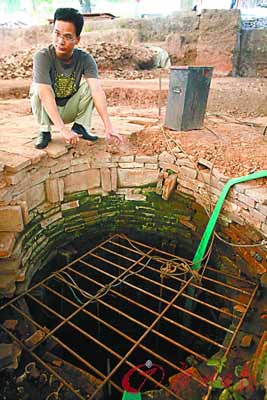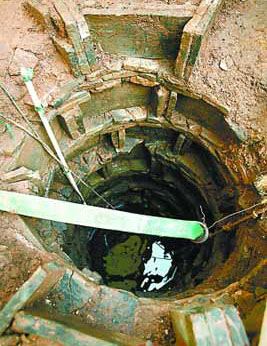Two Ancient Wells Excavated in Nanyue Kingdom Palace Site
Since the beginning of the formal excavation in 1997, more than 500 wells have been found in the strata of different periods within the area of the Palace Complex of the Nanyue Kingdom , which covers 15,000 square meters. The dates of these wells were from the Nanyue Kingdom of the Western Han Dynasty via the Eastern Han, Three-Kingdoms, Southern Dynasties, Tang, Song, Ming and Qing Dynasties and periods. That these many wells gathered densely in this area shows that during the over 2200 years, the Nanyue Kingdom Palace district had been the center of the urban life of Guangzhou .

Recently, two wells with brick-linings laid in Trigram pattern, which were dug and built during the reign of the Southern Han State in the Five Dynasties and Ten States Period, were discovered and excavated. They are the earliest wells with intact wellheads found in Guangzhou to date.
These two wells opened 2.1 meters beneath present ground and located in the corridor of the Nanyue Kingdom Palace ; the distance between them was less than eight meters. As introduced by Li Zaoxin, the director of the Archaeological Research Department of the Nanyue Kingdom Palace preparatory office, the well in the north was used for getting drinking water and the one in the south was cesspit.
The top of the wellhead of the southern well was laid with bricks in “Eight Trigram” pattern: eight courses of bricks laid in stretcher bond radiating as if from the center of the well, between each adjacent two courses bricks were paved; separated by three layers of flatly paved bricks, another set of this type of brickwork was repeated as the lining of the well. On the bottom of the southern well, remained coal cinders and sands were found, which might have been used to filter the waste water.
The “Eight Trigram” pattern of the brick wellhead was designed in the light of the principle of rigidity mechanics: the external pressure would make the well lining stronger and tighter, which showed the superb technique of well construction in the Five Dynasties and Ten States Period.
 The part closer to the middle of the wellhead of the northern well was higher than that on the edge; around the wellhead, a brick-lined gutter was built. As the analyses by the experts, the way of the wellhead building was adopted to prevent the dirt and garbage from falling into the well. The brick lining showed two different colors bordered at one meter below the top of the wellhead: the bricks above the border were grey while the ones below it were red, and the laying methods were also clearly different. This implied that this drinking water well had been used from the Five Dynasties Period to the later Northern Song Dynasty and amended and reinforced after the ruining of Southern Han State.
The part closer to the middle of the wellhead of the northern well was higher than that on the edge; around the wellhead, a brick-lined gutter was built. As the analyses by the experts, the way of the wellhead building was adopted to prevent the dirt and garbage from falling into the well. The brick lining showed two different colors bordered at one meter below the top of the wellhead: the bricks above the border were grey while the ones below it were red, and the laying methods were also clearly different. This implied that this drinking water well had been used from the Five Dynasties Period to the later Northern Song Dynasty and amended and reinforced after the ruining of Southern Han State.
The recovered ancient wells include earthen wells, brick-lined wells, tile-curbed wells, wood-lined wells, bamboo wattle-curbed wells, pottery tube-curbed wells and stone-and-brick-lined wells, all of which reflected the features of the architectural cultures over the long time. Almost all of the re-dredged wells produce clear water; the result of the examination made by relevant authorities showed that the quality of the water of these wells meets modern drinking water standard. (Translated by Ding Xiaolei)

